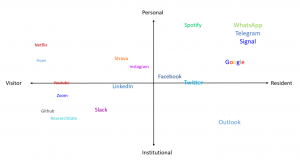After two weeks of Problem-Based Learning (PBL) with my team members, my first thoughts during this reflection exercise go out to the method rather than the material. Not sure if that was supposed to happen, but I want to dedicate a few words to it anyway before heading to the actual material that we worked with!
PBL a new learning form for me personally, and I noticed that for the first few meetings, I really had to steer myself away from looking for solutions and answers to our questions. Brainstorming on command isn’t always easy! It did however help us identify (or Focus on, according to the FISh model (Open Networked Learning, n.d.)) the questions we found most interesting. After that, we could try to deepen our knowledge and (finally! :D) could go and start the search for answers. This was done individually, but with regular check-ins with each other to check whether we were on the right path or simply sharing progress with each other.
I found the group work that we engaged in giving in that there were different working and communication styles coming together. That’s always something one can learn from, both through getting inspired and through reflection on the pros and cons of one’s own style(s). There were also more concrete moments where people’s experiences and approaches brought different value, for example when Teck Keong brought in the Community of Inquiry framework (Fiock, 2020). There were some specific activities in there that I hope to implement in courses that I teach in, but even the distinct consideration of different types of presences helped me to think differently about different aspects of courses and how one can or should play a role in these.
The discussions in the group were not the only interactive moments these past weeks, and when I think back to the theme ‘Online participation and digital literacies’ I much appreciated the video material and lecture by David White. The tweetchat left me somewhat conflicted: participating in that actively required many open tabs, quick reactions and resulted in some experienced pressure to be smart, witty and so on. However, I think the gains outweighed these initial sources of stress: the questions asked were quite thought-provoking, I got to meet members from other groups in the course and took part of some of their (interesting!) thoughts. Where the preparations made me aware of the existence of the visitor/resident spectrum, the tweetchat made me rethink some of the initial placements and distinctions I had made, and I think I would place myself as follows now:

The above is, of course, something that will keep developing at a pace somewhat similar to that of our non-digital persona(e). I think that visualising this way and thus forcing oneself to think your choices through can make one rethink and reprioritise some of them, helps develop them more consciously and so that they align better with priorities and values that one has.
References
Fiock, H. (2020). Designing a Community of Inquiry in Online Courses. The International Review of Research in Open and Distributed Learning, 21(1), 134–152. https://doi.org/10.19173/irrodl.v20i5.3985
Open Networked Learning. (n.d.). Learning activities – FISh – a model for individual, pair and PBL group inquiry. Retrieved October 3, 2022, from https://www.opennetworkedlearning.se/about-onl/learning-activities/